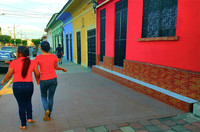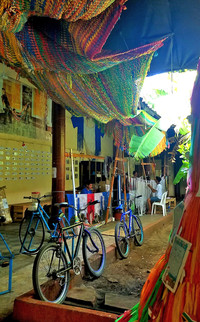By Jim Farber
From its brightly painted colonial-era houses and churches to the shimmering waters of Lake Nicaragua with its hundreds of tiny islands (isletas) to the verdant cloud-shrouded slopes of the Mombacho Volcano that dominates the landscape, Granada is a fascinating city to discover. Its people are warm, welcoming and proud of their country, anxious to dispel visions of Nicaragua left over from the U.S attempt to overthrow the Sandinista Revolution in the last century.
Today Nicaragua is prospering and reaching out to the tourist industry. An excellent infrastructure of new roads connect the country's major cities and tourist attractions such as the Mombacho Volcano Natural Reserve. Sustainable energy and recycling are a way of life. Schoolchildren study English and Spanish as part of the curriculum from kindergarten through high school. There is a minimum amount of crime, and Nicaraguans enjoy universal healthcare.
And then there is Granada.
Located about an hour's drive from the capital city of Managua, Granada was founded by Francisco Hern ndez de Cordoba in 1524 and is renowned for the abundance of beautifully preserved colonial architecture that defines the city. Every street presents itself as a rainbow of exterior colors: bright red next to blue, next to green, next to yellow, next to orange. Each street-facing facade conceals wonders within as entryways lead to a series of interior courtyards accentuated by lush gardens.
The Plaza Colon Hotel provides the perfect blend of traditional colonial architecture and contemporary comfort. Originally the homes of several renowned families, the main house and three adjoining properties were converted to form the hotel. Its graceful colonnaded facade, however, remains just as it was at the beginning of the 19th century.
The innermost courtyard contains two floors of comfortable rooms surrounding the pool and dining area, where breakfast is served each morning. Located directly on the main cathedral square, the patio of the Plaza Colon Hotel provides the ideal place to sip a rich cup of Nicaraguan coffee or relax with an evening rum cocktail as the square bustles with activity and the cacophonous chorus of birds in the trees. From the hotel you can also employ one of the many horse-drawn carriages that line up in the square to give you a leisurely, clip-clop tour of the town.
But Granada is really ideal for walking. On foot you can take the time to explore the city's main streets and byways, its myriad shops and grand churches. Be sure to climb to the top of the bell tower of Iglesia de la Merced, a favorite spot for viewing the sunset. And on Calle Cervantes you will find the Convento Museo de San Francisco and the Iglesia de San Francisco, the oldest church in Nicaragua dating back to 1529. The museum offers a wide range of historical, archeological and fine art exhibits.
In the evening the Calle la Calzada and the adjacent avenues become a gathering place for locals and visitors. The streets are lined with every type of tavern and eatery, from the elegant Hotel Dario and the Bistro Estrada to casual cafes serving fish caught from the lake, locally raised poultry, beef and vegetables.
Two side excursions are a must: a boat ride onto the lake with its many islands, some of which feature small hotels, and a walk through the cloud forests of the Mombacho Volcano. When the clouds part the volcano's hiking trails offer a panoramic view of Granada, the great expanse of the lake and the other towering volcanoes that define Nicaragua's landscape.
WHEN YOU GO
For general information: www.granada.com
I stayed at the Hotel Plaza Colon: www.hotelplazacolon.com.
For the Mombacho Volcano Reserve: www.mombacho.org

Jim Farber is a freelance writer. To read features by other Creators Syndicate writers and cartoonists, visit the Creators Syndicate website at www.creators.com.








View Comments